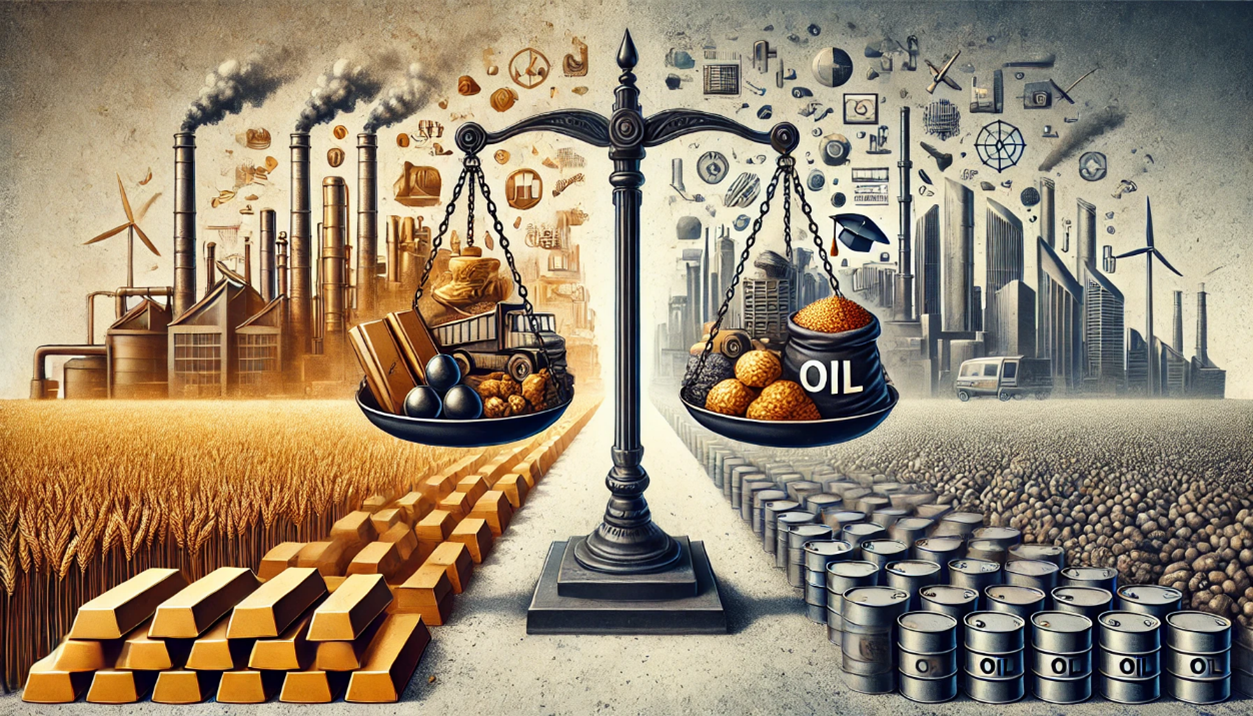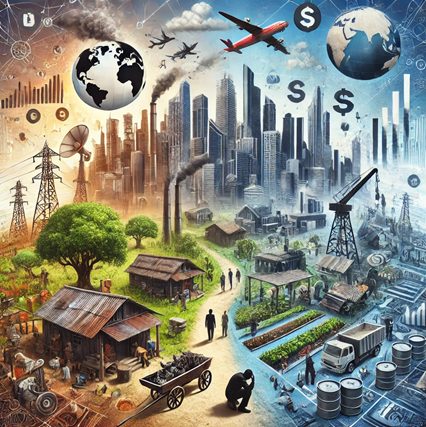What challenges do emerging economies face in sustaining high growth rates?

What challenges do emerging economies face in sustaining high growth rates?
by Nathaniel 12:09pm Jan 11, 2025

What challenges do emerging economies face in sustaining high growth rates?
Emerging economies often experience rapid economic growth as they transition from lower-income status to middle-income or higher levels. However, sustaining high growth rates over the long term presents a number of significant challenges. These challenges are diverse and stem from both internal and external factors. Here's an overview of the main challenges faced by emerging economies in maintaining sustained high growth:
1. Infrastructure Deficits
Inadequate Infrastructure: Many emerging economies suffer from underdeveloped infrastructure in areas such as transportation, energy, water, and digital networks—which can severely hinder growth. Poor infrastructure increases the costs of doing business, limits access to markets, and restricts productivity growth.
Investment Needs: Building the required infrastructure requires significant investment. However, many emerging economies face capital constraints, making it difficult to mobilize the financing needed for large-scale infrastructure projects. Additionally, corruption, inefficiency, and political instability can further complicate
these efforts.
2. Over-Reliance on Commodities
Commodity Price Volatility: Many emerging economies are heavily dependent on the export of natural resources (e.g., oil, minerals, agricultural products).This over-reliance exposes these countries to commodity price shocks,which can lead to economic instability. A decline in commodity prices can cause significant fluctuations in export revenues, impacting government budgets, foreign exchange reserves, and overall economic growth.
Lack of Diversification: Countries that remain reliant on commodity exports often struggle to diversify their economies into other sectors, such as manufacturing or services. Without diversification, the economy remains vulnerable to external price fluctuations and global demand cycles.
3. Institutional Weaknesses
Governance Issues:Weak institutions and poor governance (such as corruption,political instability, and inefficient bureaucracy) can undermine efforts to sustain high growth. Corruption can divert public resources away from productive investments, while unstable political systems can discourage both domestic and foreign investment.
Rule of Law: A lack of strong legal frameworks or property rights protection can deter investment, limit entrepreneurship, and reduce confidence in the economy. Effective contract enforcement and a transparent regulatory environment are key to attracting investment and fostering sustainable growth.
4. Education and Human Capital Constraints
Low Educational Standards: Many emerging economies struggle with deficiencies in their education systems. A lack of skilled labor can stifle innovation, reduce productivity, and limit the development of more sophisticated industries.
Brain Drain:High rates of skilled labor emigration, commonly referred to as brain drain, can exacerbate shortages of critical skills and undermine efforts to develop human capital within the country. This can create a cycle of dependency on foreign expertise while hindering the growth of local talent.
5. Income Inequality
Social Inequality:High levels of income inequality can undermine social stability and reduce the overall potential for growth. Inequality limits the ability of large segments of the population to access quality education, healthcare,and other economic opportunities. It can also create social unrest, which may undermine long-term growth prospects.
Political and Social Tensions: Inequality can fuel political instability, as marginalized groups may demand more equitable distribution of resources.The resulting tensions can reduce investor confidence and disrupt economic activities.
6. External Shocks and Global Market Integration
Global Economic Volatility: Emerging economies are often highly integrated into global markets, which means they are vulnerable to external shocks, such as global financial crises, recessions, or trade disruptions. Such events can cause significant slowdowns in export demand, capital flows, and remittances, which are critical for many emerging economies.
Climate Change: Exposure to the risks of climate change (e.g., natural disasters, resource scarcity) is particularly acute in many emerging economies, especially those dependent on agriculture or natural resources. Adverse environmental conditions can disrupt production, increase costs, and displace populations, thereby threatening growth prospects.
7. Debt Sustainability and Fiscal Challenges
Rising Public Debt:Many emerging economies face the challenge of rising public debt,often accumulated during periods of rapid growth or as a result of government borrowing to finance infrastructure or social programs. High debt levels can lead to fiscal constraints, reducing governments’ ability to respond to economic challenges and invest in critical areas like education and health.
Debt Servicing Costs:As debt levels rise, governments may face increasingly high debt servicing costs (interest payments). This can lead to a vicious cycle, where debt servicing takes up an increasingly large portion of national budgets, leaving less for other development priorities.
Currency and Inflation Risks: High debt exposure to foreign currencies also increases vulnerability to currency depreciation and inflation, which can erode purchasing power and undermine economic stability.
8. Capital Flight and Foreign Investment
Capital Flight:In some emerging economies, especially those with unstable political environments or weak legal frameworks, there is a risk of capital flight, where both local and foreign investors move their capital out of the country due to concerns about instability, inflation, or poor economic policies. This can reduce investment and hurt growth prospects.
Dependency on Foreign Investment: While foreign direct investment (FDI) can provide valuable capital, emerging economies can become overly reliant on foreign investment. The outflow of investment due to global factors, such as changing global interest rates or geopolitical tensions, can create significant vulnerabilities.
9. Technological Innovation and Digital Transformation
Technological Gap:Many emerging economies face the challenge of keeping up with technological advancements in an increasingly digital and interconnected world. Lack of access to modern technologies, innovation ecosystems, and the digital economy limits their ability to increase productivity, improve services, and compete in global markets.
Investment in Research and Development (R&D): While some emerging economies have made strides in technological innovation, many still fall short in investing in research and development (R&D). Countries that do not prioritize technological progress risk falling behind in the global economy, which could hinder their growth prospects.
10. Demographic Pressures
Youth Bulge:Many emerging economies have young populations, which can be an asset if the right investments are made in education and employment. However, unemployment or underemployment of the youth can lead to social tensions, a loss of human capital, and missed opportunities for economic growth.
Aging Populations:On the other hand, some emerging economies are experiencing population aging, which can strain social security systems, reduce the available labor force, and increase healthcare costs, leading to fiscal pressures that hinder growth.
11. Political Instability and Policy Inconsistency
Frequent Policy Shifts: Political instability and policy uncertainty can discourage both domestic and foreign investment. When governments frequently change policies, or fail to implement long-term strategies, businesses and investors may hesitate to make commitments, slowing down growth.
Populist Policies:Sometimes, emerging economies face the risk of adopting populist or unsustainable economic policies that promise short-term gains but ultimately hinder long-term growth. For example, policies that lead to unsustainable public spending, inflation, or trade imbalances can derail economic progress.
12. Global Trade and Protectionism
Trade Barriers:Emerging economies may face challenges in accessing global markets due to rising protectionism and trade barriers, such as tariffs or non-tariff barriers, imposed by advanced economies. This restricts their ability to export goods, receive foreign investments, and integrate into global value chains.
Trade Dependency: Economies that are overly dependent on trade (especially exports of a few commodities) can struggle when global trade dynamics change or if there is a downturn in demand for their primary products. Trade disruptions can significantly affect growth and development prospects.






